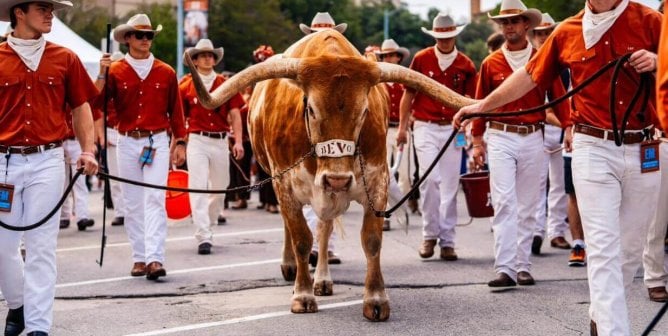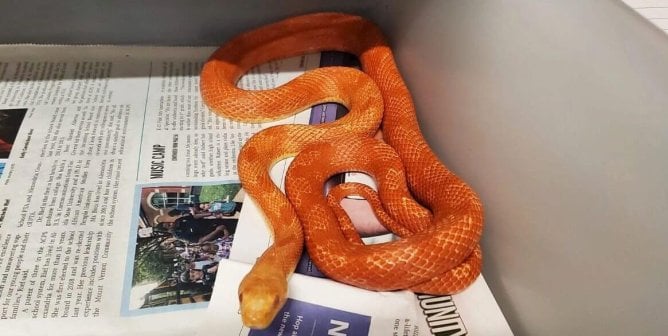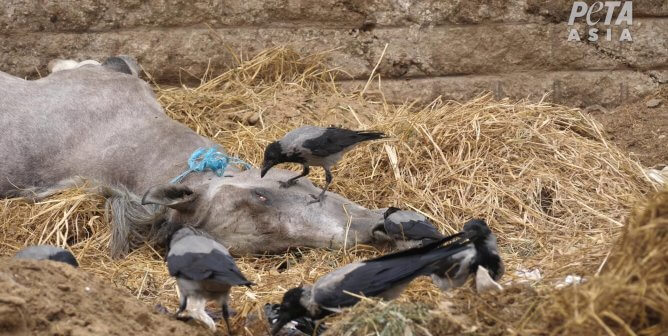Marine Animal Exhibits: Chlorinated Prisons
At aquariums around the country, orcas leap through the air for a handful of fish, and tourists flock to facilities that offer them the opportunity to swim or have their pictures taken with dolphins. These parks and zoos are part of a billion-dollar industry built on the suffering of intelligent, social beings who are denied everything that is natural and important to them.1 Ric O’Barry, who was a dolphin trainer for the Flipper television series in the 1960s, says that parks and zoos “want you to think that God put [dolphins] there or [that] they rescued them. … If people knew the truth, they wouldn’t buy a ticket.”2
Families Torn Apart
Killer whales, or orcas, are members of the dolphin family. They are also the largest animals held in captivity. In the wild, orcas stay with their mothers for life. Family groups, or “pods,” consist of a mother, her adult sons and daughters, and her daughters’ offspring. Members of the pod communicate in a “dialect” specific to that pod. Dolphins swim together in family pods or tribes of hundreds.
Capturing even one wild orca or dolphin disrupts the entire pod. To obtain a female dolphin of breeding age, for example, boats are used to chase the pod into shallow waters, where the animals are surrounded with nets that are gradually closed and lifted onto the boats. Unwanted dolphins are thrown back. Some die from shock or stress, and others slowly succumb to pneumonia when water enters their lungs through their blowholes. Pregnant females may spontaneously abort babies. In one instance, more than 200 panicked dolphins who had been corralled into a Japanese fishing port crashed into boat hulls and each other, becoming hopelessly entangled in nets during their attempt to find an escape route. Many became exhausted and drowned.3
Orcas and dolphins who escape the ordeal of capture become frantic upon seeing their captured companions and may even try to save them. When Namu, a wild orca captured off the coast of Canada, was towed to the Seattle Marine Aquarium (then the Seattle Public Aquarium), he was insured by Lloyd’s of London, according to the BBC, for “various contingencies including rescue attempts by other whales.”4
Adapting To An Alien World
In the wild, orcas and dolphins swim in vast oceans and rivers. But captured dolphins are confined to tanks that may be only 24 feet long, 24 feet wide, and 6 feet deep.5 They navigate by echolocation—bouncing sonar waves off other objects to determine their shape, density, distance, and location—but in tanks, the reverberations from their own sonar bounce off the walls, driving some dolphins insane. Jacques Cousteau said that life for a captive dolphin “leads to a confusion of the entire sensory apparatus, which in turn causes in such a sensitive creature a derangement of mental balance and behaviour.”6
Newly captured dolphins and orcas are forced to learn tricks. Former trainers say that withholding food and isolating animals who refuse to perform are two common training methods. According to O’Barry, “positive reward” training is a euphemism for “food deprivation.”7 Former dolphin trainer Doug Cartlidge maintains that highly social dolphins are punished by being isolated from other animals: “You put them in a pen and ignore them. It’s like psychological torture.”8
Captivity’s Tragic Consequences
If life for captive orcas and dolphins were as tranquil as marine parks would have us believe, the animals would live longer than their wild counterparts. However, while captive marine mammals are not subject to predators or ocean pollution, their captivity is nevertheless a death sentence.
In the wild, dolphins can live into their 40s and 50s.9 But more than 80 percent of captive dolphins whose ages could be determined died before they turned 20, and those at SeaWorld and other marine parks rarely survive for more than 10 years.10,11
The San Antonio News Express analyzed data submitted by SeaWorld to the National Oceanic and Atmospheric Administration and discovered that almost 150 sea lions, beluga whales, orcas and dolphins have died from infections since 1986, out of a total of 816 listed under the parks’ care.12 Florida’s Sun-Sentinel examined 30 years of federal documents pertaining to marine animals and found that nearly 4,000 sea lions, seals, dolphins, and whales have died in captivity, and of the 2,400 cases in which a cause of death was listed, one in five animals died “of uniquely human hazards or seemingly avoidable causes.”13 Captive marine mammals have died from swallowing coins, succumbing to heatstroke, and swimming in contaminated water.
The Trouble With ‘Interactive’ Programs
Many aquariums are now offering touch tanks and “swim-with” programs, giving visitors carte blanche to invade these animals’ already diminished worlds.
When the Georgia Aquarium announced that it was going to start allowing a dozen swimmers in the tank with its whale sharks every day, George Burgess, director of the Florida Program for Shark Research at the Florida Museum of Natural History, told the Los Angeles Times that subjecting animals to these programs is like “being in a bedroom for the rest of your life after having had the ability to walk around freely …. And then having 20 people come join you in your personal space every so often.”14 At least 15 dolphins housed at The Mirage’s Dolphin Habitat in Las Vegas, where patrons can pay to be a “trainer” for a day, have died since the facility opened in 1990.15 Four dolphins died within a year and a half at an Arizona facility, forcing the temporary closure of the site while an investigation was conducted. One marine mammal scientist noted that the desert sun is harsh for dolphins, and that “(t)he relentless exposure to UV radiation is not normal for them.”16 Thirty-year-old Sharky died of head injuries when she collided in mid-air with another dolphin while forced to perform tricks as part of SeaWorld’s Discovery Cove, where tourists participate in the “swim with dolphins” program.17
Even dolphin-assisted therapy can be dangerous—not only for the animals but also for the mentally or physically disabled patients hoping to get some kind of “healing” experience. “Dolphin-assisted therapy is not a valid treatment for any disorder,” says Lori Marino, a dolphin and whale researcher from Emory University. She adds that “injury is a very real possibility when you place a child in a tank with a 400-pound wild animal that may be traumatized from being captured.”18
Touch tanks are also death traps for animals. Forty stingrays died from an unknown toxin in the Calgary Zoo’s touch tank within three months after the exhibit opened.19 This mass death was not an isolated incident: 54 stingrays died in the tank at the Brookfield Zoo in Illinois, and 18 died at John Ball Zoo in Michigan.20,21
The Way Forward
Richard Donner, coproducer of the film Free Willy, said, “Removal of these majestic mammals from the wild for commercial purposes is obscene. … These horrendous captures absolutely must become a thing of the past.”22
People around the world are recognizing that dolphins, orcas, and other cetaceans do not belong in captivity. Mexico City banned the use of dolphins and other marine mammals in shows, therapy sessions and scientific experiments.23 France does not allow the breeding in captivity of dolphins and killer whales.24 India’s Ministry of Environment and Forests announced that the country would no longer permit dolphins to be kept in captivity for entertainment, stating that to do so would be “morally unacceptable.”25 Canada does not allow beluga whales to be captured and exported.26 Israel prohibits the importation of dolphins for use as entertainment.27
What You Can Do
Don’t visit parks or zoos that have captive marine mammals unless you’re doing so to monitor the animals as part of a campaign. Encourage your local aquarium to stop breeding animals in order to make space for rehabilitating (and releasing) injured wildlife. Report poor conditions to the U.S. Department of Agriculture, leaflet at the park, write letters to the editors of local publications, and pressure officials to avoid subsidizing these facilities with taxpayer money. Support legislation that prohibits the capture or restricts the display of marine mammals.
References
1Sally Kestin, “Not a Perfect Picture,” Sun-Sentinel 16 May 2004.
2Kestin.
3Public Broadcasting Service, “A Whale of a Business,” Frontline 1998.
4BBC News, “Lloyd’s: Insuring the Famous and the Bizarre,” 29 Oct. 1999.
5Animal and Plant Health Inspection Service, “3.104 Space Requirements.”
6Virginia McKenna, Into the Blue (New York: Harper Collins Publishers, 1992).
7McKenna.
8Ibid.
9Sally Kestin, “Experts, Parks Debate Animal’s [sic] Ages of Death,” Sun-Sentinel 16 May 2004.
10Kestin, “Not a Perfect Picture.”
11Ibid.
12Richard Webner,”What’s Killing The Orcas at Sea World?” San Antonio News-Express 20 May 2016.
13Kestin.
14Richard Fausset, “Too Close for Their Comfort? Atlanta’s Aquarium Lets the Public Pay to Get in the Tank With Sharks,” Los Angeles Times 19 June 2008.
15Henry Brean, “Secret Garden Attraction at The Mirage Earns Animal Welfare Certification,” Las Vegas Review-Journal 25 Apr. 2017.
16Beth Dalby, “Dolphins Mysteriously Dying At Swim-With-Dolphins Tourist Trap,” Patch.com 6 Feb. 2019.
17Jacqui Goddard, “Dolphin Dies as Aerial Stunt for Tourists Goes Wrong,” The Times (London) 29 Apr. 2008.
18Emory University, news release, “Dolphin ‘Therapy’ a Dangerous Fad, Emory Researchers Warn,” EurekaAlert.org, 18 Dec. 2007.
19CBC News, “5 More Stingrays Die as Calgary Zoo Asks Police for Help,” 14 May 2008.
20Deanese Williams-Harris, “Brookfield Zoo Investigating Cause of Malfunction that Left 54 Stingrays Dead,” Chicago Tribune 13 July 2015.
21Katie Lathrop, “Grand Rapids Zoo’s Stingray Exhibit Remains Closed,” WZZM, 12 July 2016.
22Donner/Shuler-Donner Productions, news release, “Sea World Tossed Out as Sponsor for American Oceans Event,” 20 Mar. 1995.
23Emily Green, “Mexico City Is Banning Dolphin Shows, Taking A Lead on Animal Rights,” PRI’s The World 25 Aug. 2017.
24“France Bans Captive Breeding of Dolphins And Killer Whales,” BBC News 7 May 2017.
25Environment News Service, “India Bans Captive Dolphin Shows as ‘Morally Unacceptable,’” 20 May 2013.
26Brian McHattie, letter to Ann Terbush, U.S. Department of Commerce, “Comments on National Marine Fisheries Service Proposed Rule—Docket No. 001031304-0304-01,” 31 Oct. 2001.
27Reuters, “Israel Agency Bans Import of Dolphins,” 4 Feb. 1994.








